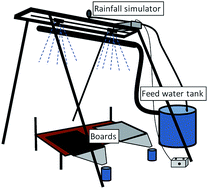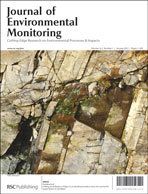Contaminants deposited on impermeable surfaces migrate to stormwater following rainfall events, but accurately quantifying their spatial and temporal yields useful for mitigation purposes is challenging. To overcome limitations in current sampling methods, a system was developed for rapid quantification of contaminant build-up and wash-off dynamics from different impervious surfaces. Thin boards constructed of concrete and two types of asphalt were deployed at different locations of a large carpark to capture spatially distributed contaminants from dry atmospheric deposition over specified periods of time. Following experimental exposure time, the boards were then placed under a rainfall simulator in the laboratory to generate contaminant runoff under controlled conditions. Single parameter effects including surface roughness and material composition, number of antecedent dry days, rain intensity, and water quality on contaminant build-up and wash-off yields could be investigated. The method was applied to quantify spatial differences in deposition rates of contaminants (TSS, zinc, copper and lead) at two locations varying in their distance to vehicle traffic. Results showed that boards exposed at an unused part of the carpark >50 m from vehicular traffic captured similar amounts of contaminants compared with boards that were exposed directly adjacent to the access route, indicating substantial atmospheric contaminant transport. Furthermore, differences in contaminant accumulation as a function of surface composition were observed. Runoff from asphalt boards yielded higher zinc loads compared with concrete surfaces, whereas runoff from concrete surfaces resulted in higher TSS concentrations attributed to its smoother surfaces. The application of this method enables relationships between individual contaminant behaviour and specific catchment characteristics to be investigated and provides a technique to derive site-specific build-up and wash-off functions required for modelling contaminant loads from impermeable surfaces.

You have access to this article
 Please wait while we load your content...
Something went wrong. Try again?
Please wait while we load your content...
Something went wrong. Try again?


 Please wait while we load your content...
Please wait while we load your content...